|
|
Post by grahamew on Dec 19, 2010 14:03:27 GMT -5
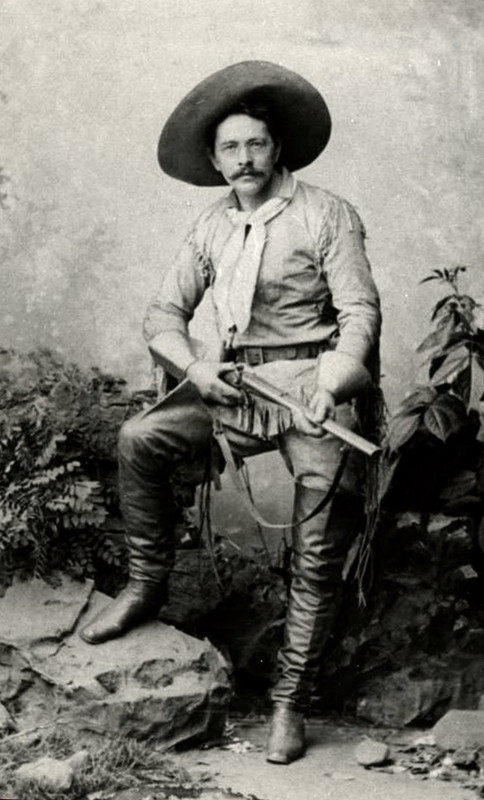 Cronau, 1882 Solingen-born artist Rudolf Cronau was working for the German newspaper Die Gartenlaube when, in 1881, he travelled to Standing Rock where he lived for three weeks with the Hunkpapa who camped away from the agency itself then he left for Fort Randall, where he made several Indian drawings. He only stayed there a week, but claimed to have made friends with Sitting Bull, for whom he wrote letters to Washington. Although later that decade, he continued to travel through America, he never returned to Standing Rock, though he did tour Germany and Austria with some Oglala from Pine Ridge. I've seen SOME of his sketches made amongst the Lakota and Dakota, but would love to see more if anyone has them and is willing to share. 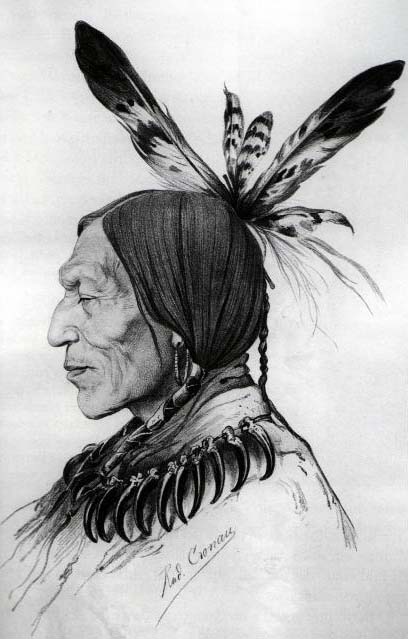 I had this man as Jagoo, the Storyteller, an Ojibwe, but Gregor has pointed out that it has since been identified as a Four Horns, Sitting Bull's uncle, by the German ethnologist Dr. Peter Bolz 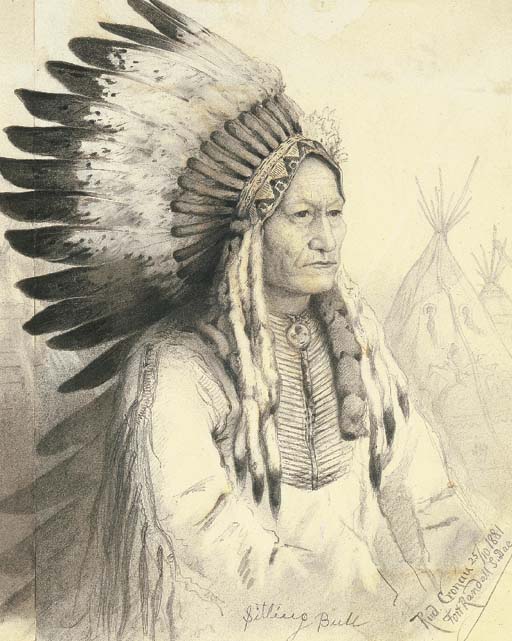 Sitting Bull 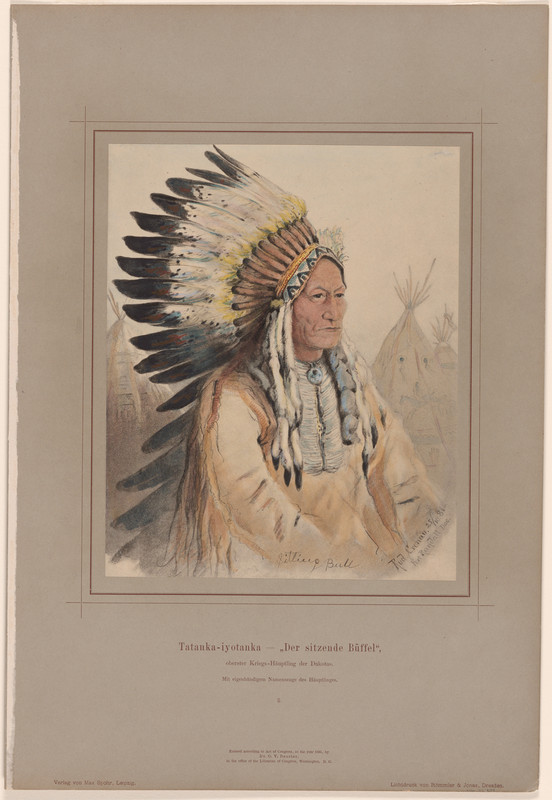 Colour print of the above 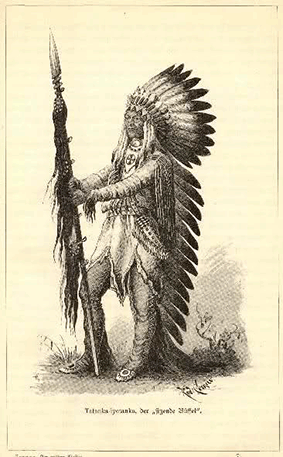 Full length Sitting Bull, which, perhaps, owes a bit to Bodmer... 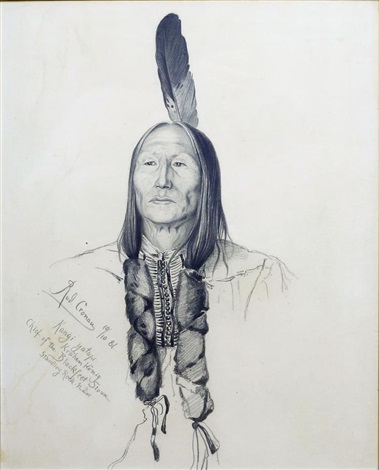 Crow King 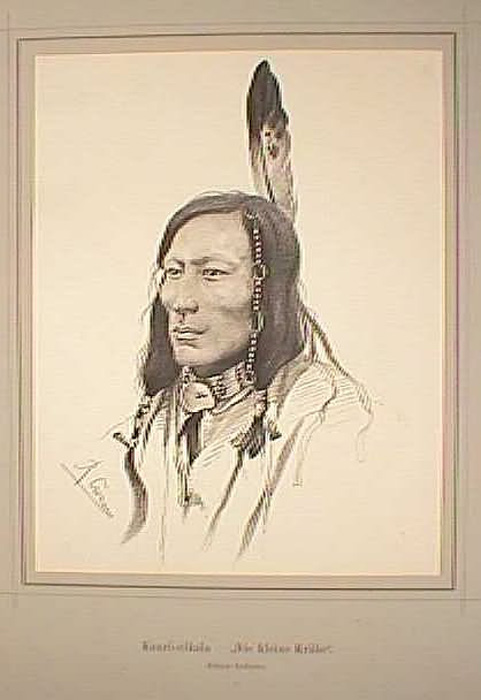 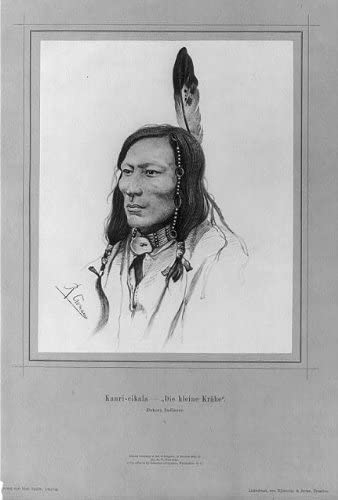 Little Crow, Miniconjou 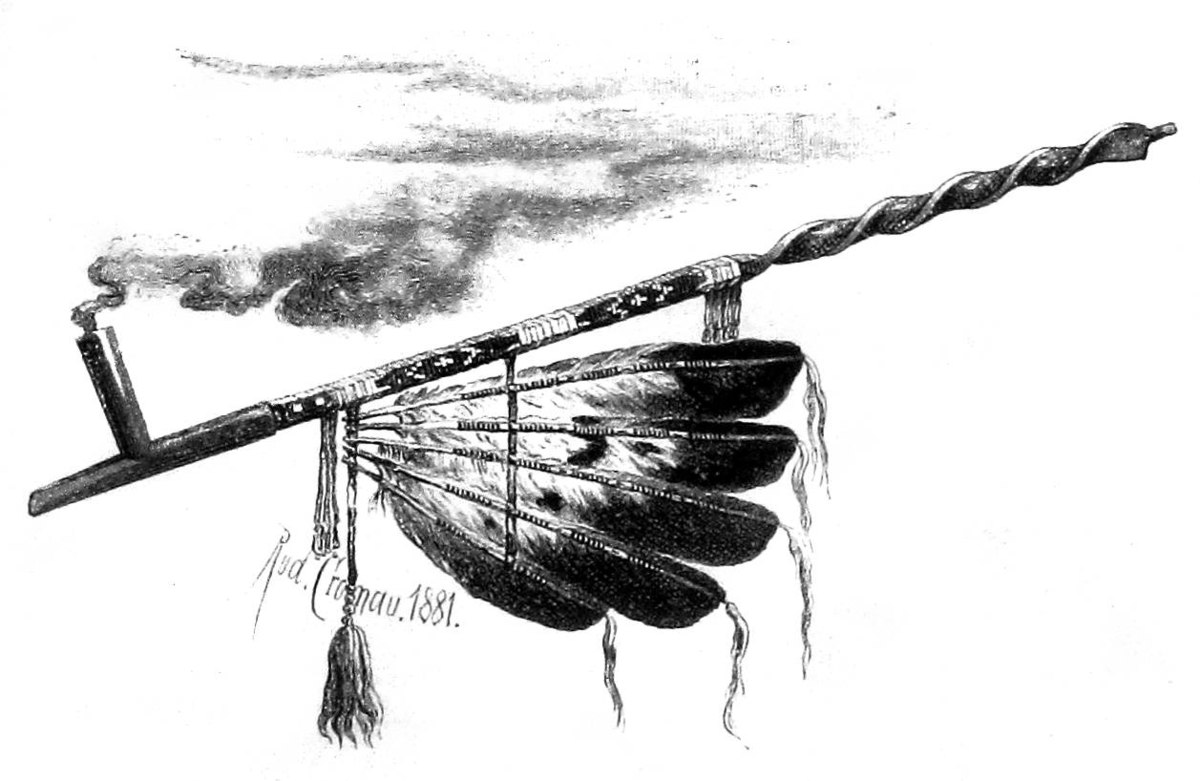 Pipe, 1881 (from Die Gartenlaube) 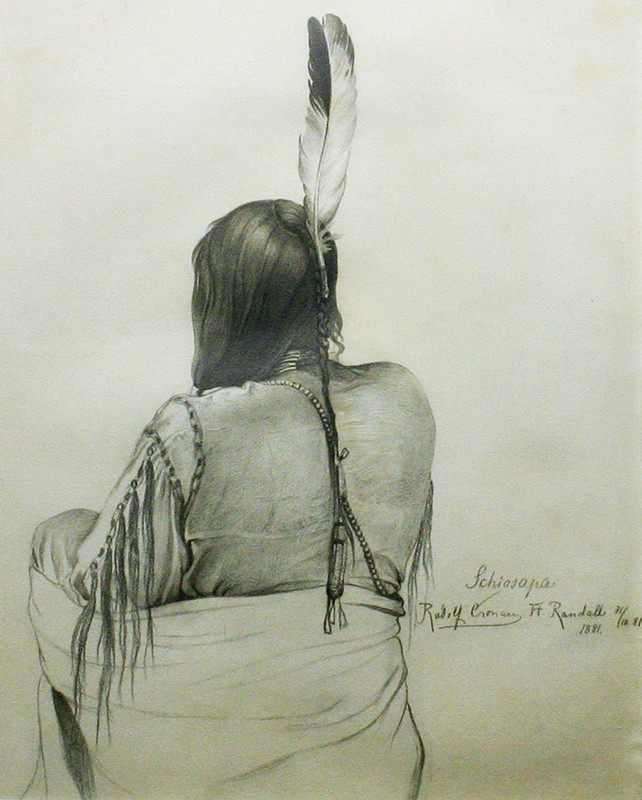 Schio Sapa 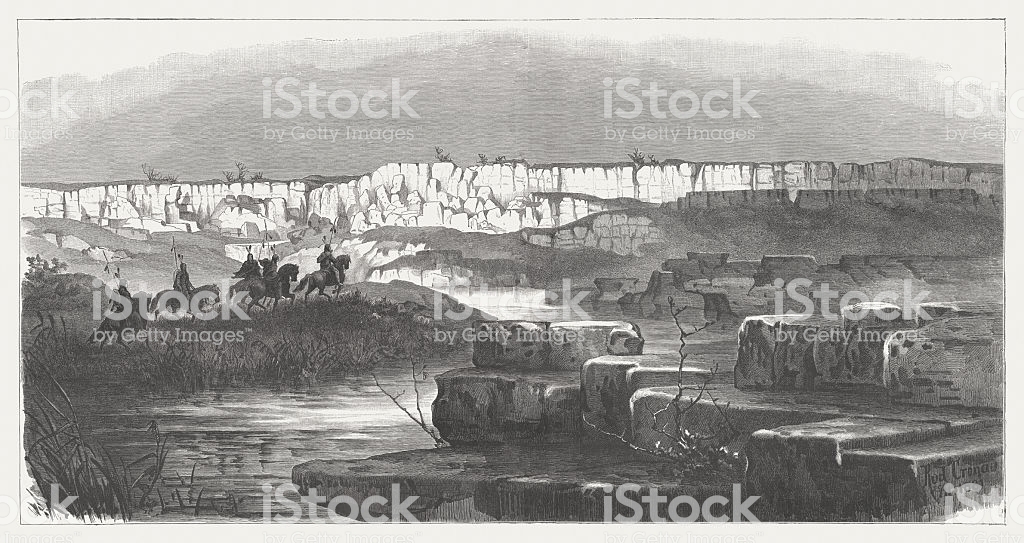 Red Pipestone Quarry (from Die Gartenlaube)  Yanktonais working in Pipestone Quarry 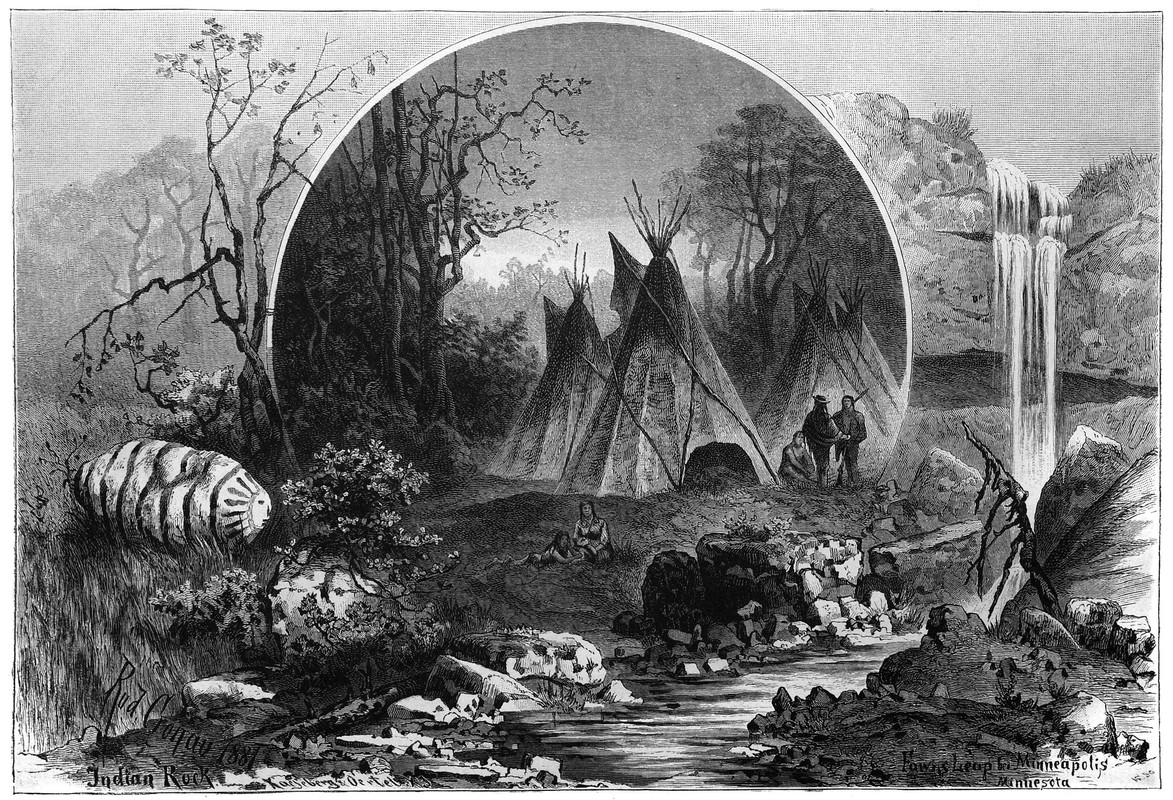 Scene at Fort Snelling The strange painted rock near the foreground is, I believe, the Red Rock that you can read about here: collections.mnhs.org/MNHistoryMagazine/articles/36/v36i01p018-023.pdfClearly, some of these have been worked up into more romanticised pictures, but I'd be interested to see any more of the portraits that were made at Standing Rock and Fort Randall He travelled widely in America and made works featuring other Indians. 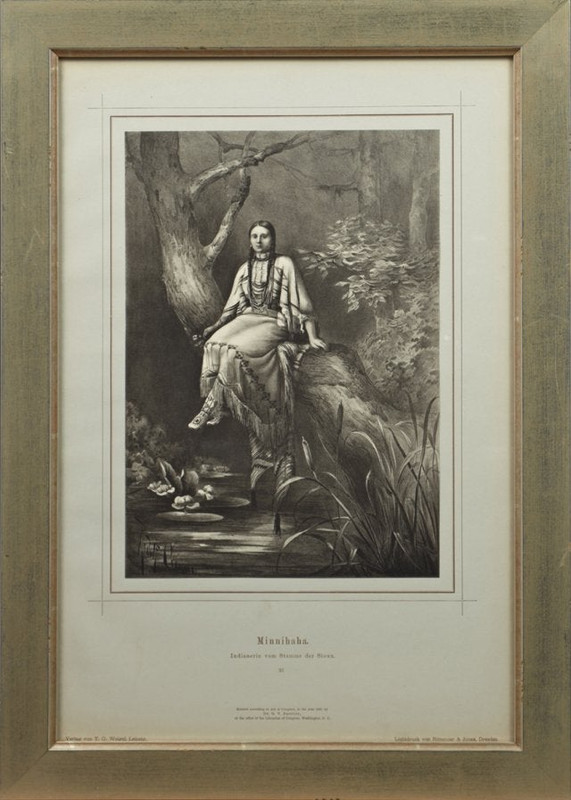 Minnehaha  Haida village 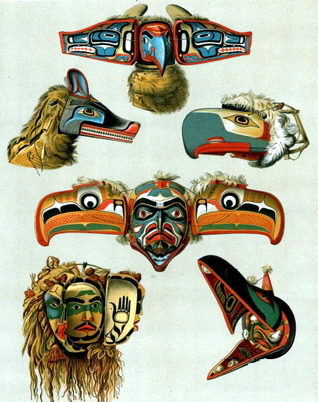 Kwakwaka'wakw/Kwakiutl masks 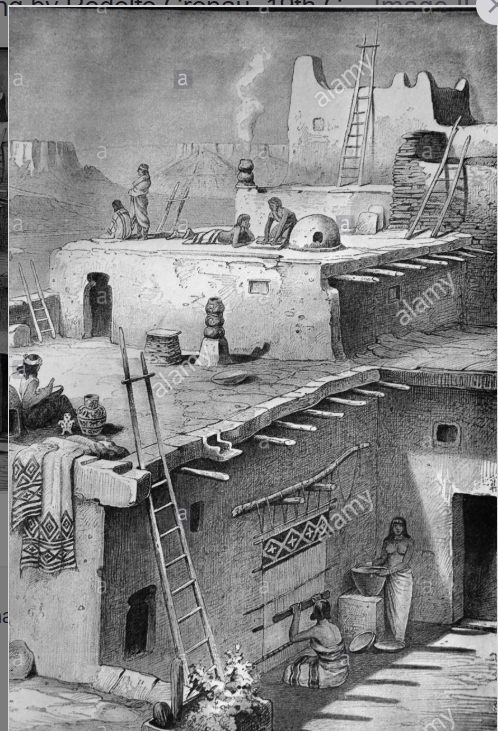 Among the Pueblo tribes We have a correspondent here, Miyelo or Kiktayokangi, whose relative, Sinte, met Cronau, possibly while with Buffalo Bill (or maybe he was one of the Oglalas who Cronau took around Germany and Austria) and drew several pictures for him. Here's one of the drawings that Sinte made for Cronau: 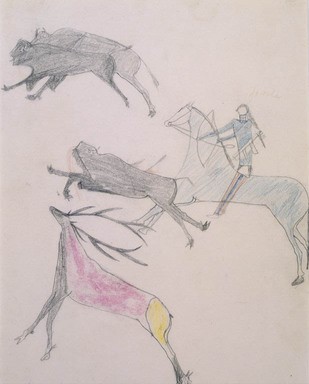 An interesting addition to all this, taken from: www.bonhams.com/auctions/12976/lot/3356/#/! "[SITTING BULL. 1831?-1890.] PHOTOGRAPH WORN AROUND SITTING BULL'S NECK AT TIME OF HIS DEATH. CRONAU, RUDOLF. 1855-1939. Cabinet-size albumen print, 4 1/4 by 6 1/2 inches, being a head and shoulders portrait of artist Cronau, by W. Kurtz of New York, signed and inscribed on the verso, "To his friend / Tatanka-iyotanka (Sitting Bull) / Rudolf Cronau," additionally inscribed "Special artist & Correspondent / of the "Gartentaube" / Leipzig Germany," water stains, wear, 1/2 inch loss at upper center margin of recto, dark stains to left and right margins of verso, second inscription traced over. Together with Autograph Manuscript of Cronau, 6 pp, 4to and 8vo, n.p., n.d., explaining the history of the photograph above, plus related correspondence and notes in English and German, 1897-1936, tracing the journey of the photograph from the time of Sitting Bull's death. In 1881 German artist and journalist Rudolf Cronau was the first Westerner to paint Sitting Bull from life. The older Sioux chief and the younger German journalist struck up an unlikely friendship, and when Cronau departed Sitting Bull's camp, he gave the chief this signed and inscribed photograph. In 1890 Sitting Bull was murdered as Lakota policemen, acting at the behest of the U.S. government, attempted to arrest him in order to prevent his participation in the Ghost Dance, a Plains Indian ritual with apocalytic overtones. Seven years after Sitting Bull's death, a friend of Cronau's was visiting Los Angeles and passed by the window of Cambell's Curio Store on South Spring street. There he was stunned to see Cronau's photograph among a group of Indian relics belonging to Sitting Bull. Cronau entered into correspondence with W.D. Campbell, the proprietor of the store (Campbell's letters are present here), and learned that Sitting Bull was wearing Cronau's photograph on a string around his neck at the time of his death, that it was stained with Sitting Bull's blood, and that the photograph and other relics were collected by a Standing Rock Indian trader named Mr. Angevine. Campbell offered Cronau the photograph for $25, but Cronau instead offered to trade artwork for the piece. Campbell refused, and the photograph was sold to another client. (Later records indicate the buyer was a Mr. T.S. Lowe of Los Angeles.) In 1921 Cronau discovered that the photograph was on display at the Museum of the California Academy of Science in San Francisco. Again Cronau pursued the photograph, but was not able to purchase it from the William Fitzhugh estate which had loaned it to the museum. Instead the photo traveled to the Museum of the American Indian in New York, curated by Dr. George Heye. FInally, in 1936, Cronau convinced Heye to trade the photograph for one of Cronau's paintings, and thus the photograph made its way back to its original owner, to be married to the considerable archive of correspondence and manuscripts Cronau had accumulated over the decades."   According to Christian Feest in 'Germany's Indians in a European Perspective', from Germans and Indians: fantasies, encounters, projections By Colin Gordon Calloway, Gerd Gemünden, Susanne Zantop, when Cronau found the photo was for sale in 1895, he found out it wasn't stained with Sitting Bull's blood and the Lakota had not been wearing around his neck when he was shot. He refused to buy it for $1000 but acquired it nearly 40 years later from George Heye, the founder of the Museum for the American Indian. When Cronau's own account of the story behind the photograph was published around the time of his death in 1939, he repeated the tale about Sitting Bull wearing the picture at the time of his death. Another interesting addition: Cronau's great gandson, Howard Junker, a writer and editor living in San Francisco, had a blog (http://zyzzyvaspeaks.blogspot.com/2009_07_01_archive.html), on which he has talked about his relative and posted pictures of examples of "some of the beadwork Sitting Bull gave him" which "is now in my living room." Sadly, this is no longer online... IT's possible I've saved the photos, but not on this PC |
|
|
|
Post by grahamew on Dec 20, 2010 12:39:33 GMT -5
Henri has very kindly sent me some more Cronau images. 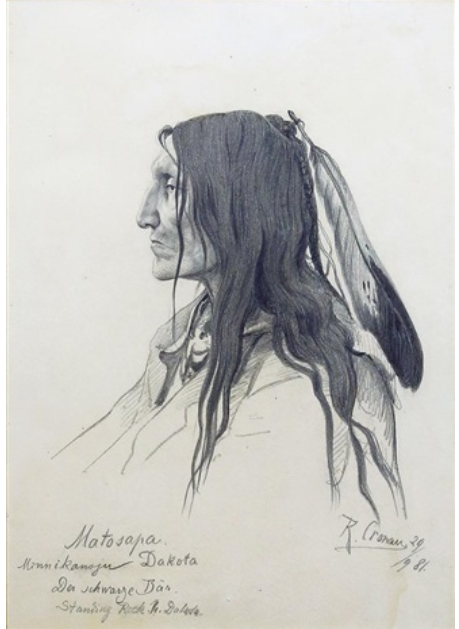 Black Bear, Miniconjou, Standing Rock 1881 i.postimg.cc/DfbxPKGg/H5989-L138724796.jpgOne Bull, Hunkpapa, Fort Randall, 1881 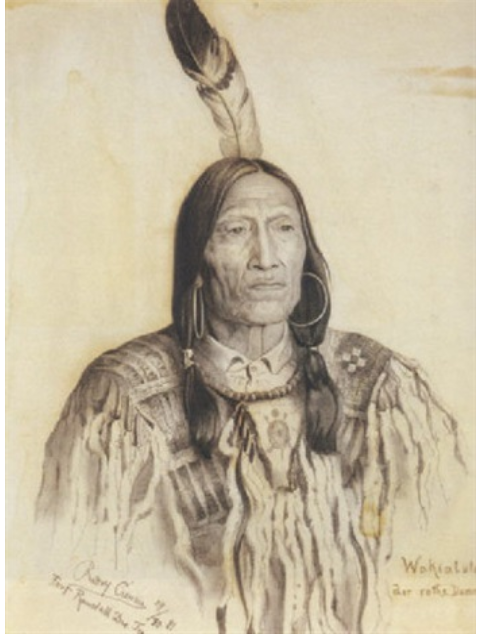 Red Thunder, Fort Randall, 1881 After Tinypic shut down, we lost a lot of images. There were several others but I can't locate their images on the internet and they're not on this computer. Edit - just posted them further on in the thread. Thanks again, Henri |
|
|
|
Post by grahamew on Dec 21, 2010 13:57:05 GMT -5
.
|
|
|
|
Post by gregor on Dec 23, 2010 12:14:54 GMT -5
Hi grahamew,
really amazing these portrait sketches. I've never seen them before. You are right, the "newspaper works" are really generic; perhaps this is due to the newspaper illustrators.
By the way the last picture is most likely not from Cronau. The text of the pic says "Sioux Indians in Germany - Drawn from photographs by F.Waibler". F. (Friedrich?) Waibler was a german artist and illustrator for the newspaper "Illustrierte Zeitung" in the 1880s. Maybe this are Lakota brought to Germany by Frank Harvey in 1886. Cronau accompanied this "Indianer Show" for a while as journalist.
A very Happy Holiday season from Germany - Gregor
|
|
|
|
Post by grahamew on Dec 23, 2010 14:29:23 GMT -5
Thanks for that, Gregor.  If I've understood Henri correctly, Cronau met the Oglala in 1886 in Germany and visited them when they returned to the USA, where he received several gifts, such as the cradleboard (composite image by Henri). On the AMNH site ( anthro.amnh.org/anthropology/databases/common/public_access.cfm?database=north ) there are a number of Indian items collected by Cronau, some from the Oglala; some from Standing Rock and Fort Randall. Amongst them are a few that purportedly belonged to Sitting Bull, like this pipe bag:  Some of the items were sketched by Cronau and appeared in print. This quiver, for example:  This club, which you can see from the illustration, formerly had three blades:   'Medicine':  Here's one of the illustrations as it appeared in Die Gartenlaube:  Three other Lakota drawings are also at the AMNH site ( anthro.amnh.org/anthropology/databases/common/public_access.cfm?database=north ) All by Sinte? If you look at this site, www.balchinstitute.org/manuscript_guide/html/cronau.html , reference is made to drawings by 'braves of Chief Sitting Bull,' so maybe this is not the case. Thanks, yet again, to Henri. |
|
|
|
Post by grahamew on Dec 24, 2010 4:42:25 GMT -5
|
|
|
|
Post by kingsleybray on Dec 24, 2010 6:37:05 GMT -5
grahamew, henri, and everyone thanks for sharing the amazing Cronau images. Merry Christmas to everyone on the boards.
Kingsley
|
|
|
|
Post by gregor on Dec 26, 2010 8:22:10 GMT -5
Here's another picture of Cronau: "Standing Rock Reservation, Sept. 23, 1881 ".  Referring to the dates in his pictures - though they are not always very accurate - we can conclude on Cronau’s stays at Standing Rock and Fort Randall. Standing Rock: from the middle of-September to Mid-October 1881. During this time he created the following images / Portraits: September 20: Mato Sapa September 23: Standing Rock Reservation September 24: Hump “September 1881”: Jagoo/He Topa, Rain-In-The-Face, His Pipe, White Magpie September 29: Little Crow October 10: Crow King At Standing Rock Cronau must have missed Sitting Bull only for days (SB started to Fort Randall on Sept. 10 and arrived at the Fort on September 18th). As to this date we have a little problem with the Jagoo/He Topa drawing. As mentioned before the german Ethnologist Dr. Peter Bolz identified Jagoo as He Topa (see: Sitting Bull und seine Welt / SB and his World, 2010, p.139). Unfortunately I don’t know his reasons. We know Cronau didn’t meet SB at Standing Rock, because he was on his way to Ft. Randall. And He Topa/Four Horns was with Sitting Bull. So, the drawing Jagoo/He Topa (drawn in Sept. 1881) can’t be Four Horns or the date is wrong – and it seems that Cronau was not always that accurate. Cronau met Sitting Bull on October 23 or 24 at Fort Randall. We can assume that he arrived a day or two before. On October 25 he made the famous SB portrait with the war bonnet. On the following days he produced the these portraits: October 29: Wakia Luta / Wakinyan Luta October 31: Schio Sapa / Siyo Sapa “Oct. 1881”: One Bull (2x) In early November 81 Cronau left Fort Randall. Due to health problems he returned to Germany in 1883. In 1898 he migrated to the USA, where he died in 1939. According to his works, we can say that his drawings from Standing Rock and Fort Randall – portraits, camp life and objects - are authentic. A lot of his other works – landscapes, burial grounds, groups – are highly imaginative and can be traced often to Bodmer and Catlin. |
|
|
|
Post by Dietmar on Dec 26, 2010 9:38:32 GMT -5
Thank you all for contributing to this thread. Very, very interesting, especially the portraits.
Gregor, you really disappointed me. I had hoped there were even more portraits of the Lakotas at Standing Rock and Fort Randall sketched by Cronau.
What do we know about men like Black Bear, His Pipe, White Magpie, Little Crow, Shiyo Sapa and Red Thunder? I´ll have to take a look in Ephriam´s commented census.
|
|
|
|
Post by gregor on Dec 26, 2010 13:11:58 GMT -5
Sorry Dietmar,
I did not want to disappoint you, but that are all portraits I know (and mostly from American-Tribes! ;D). I searched the net for two days to find more - niente! But that must not mean that there are no other pictures.
The portraits are mostly published in Cronau's "Im Wilden Westen. Eine Künstlerfahrt durch die Prairien...1890 / In the Wild West. An Artists Journey through the prairies..). We find this book on archive.org. But unfortunately the pictures are omitted. I know there are reprints on the market, i will look for a book.
After Cronau's death the Gilcrease Museum in Tulsa, Oklahoma bought some of his oil paintings. The pencil and charcoal drawings and aquarell paintings remained family property.
Maybe some are still property of art dealer, Gerold M. Wunderlich his grand Grandchild. Wunderlich has published different books on Cronau.
CU in 2011 - Gregor
|
|
|
|
Post by gregor on Dec 26, 2010 13:59:15 GMT -5
And here some little gadgets: Crow King  One Bull  Rain-In-The-Face  Hump  Could this be the Mnikowozu Hump (here in 1906) in his younger years? I think there is a likeness. |
|
|
|
Post by grahamew on Dec 28, 2010 7:30:42 GMT -5
In my first post, I said Cronau was only at Fort Randall a week, but Dennis Pope (in Sitting Bull: Prisoner of War, published by South Dakota State Historical Society Press, 2010) suggests Iron Eyes (Ista Masa), as he was called because of his spectacles), met Sitting Bull on October 23rd, made the image of him on the 25th and didn't leave until the middle of November.
At some point towards the end of his stay, post commander Colonel Andrews invited Cronau to exhibit his works and the Hunkpapas at Fort Randall were 'enthralled' when they recognised their friends in the Standing Rock paintings.
The first independent request for Sitting Bull's release came in a letter from Cronau to Hiram Price, the Commissioner for Indian Affairs in December 1881. Part of the letter is printed in Pope's book (p.122).
Re: Jagoo. He is, of course, the 'marvellous' storyteller in Longfellow's Hiawatha, so I think we can assume that Cronau's Jagoo (Four Horns or not) is a Lakota given that appellataion by the artist for having similar qualities and that it has nothing to do with the sitter being an Ojibwe.
|
|
|
|
Post by miyelo on Dec 30, 2010 22:27:18 GMT -5
Hi Graham yes that was me. Sinte is our grandpa's grandpa. he lived and rode with Crazy Horse and is in the surrender ledgers. We believe Cronau met Sinte when he was taken on the Buff Bill Wild West Show. Cronau loved Sinte's drawings as they were different from all the others. We have only seen his drawings in books, and grandpa saw some in a museum in Germany once but we do not own any, unfortunately. Just found another photo of him the other day and wrote the guy who is selling them but he has not written back. the link is here: www.american-indian-artwork.com/american-indian-picture.htmthat is Sinte. The guy asks about who the man is so I wrote him with info and asked him to give us a print but he did not reply. Just so wrong.Thanks for the info and pix of Cronau. |
|
|
|
Post by grahamew on Dec 31, 2010 5:28:44 GMT -5
This one?  |
|
|
|
Post by Dietmar on Dec 6, 2011 11:49:09 GMT -5
Here´s a well written essay on Rudolf Cronau by Glenn Penny. He is associate professor of Modern European History at the University of Iowa. www.common-place.org/vol-11/no-04/reading/edit: H. Glenn Penny
The German Love Affair with American Indians
Rudolf Cronau's Epiphany
 Cronau's melancholy, however, gave way to anger as he found what he sought in Dakota Territory. His goal in traveling there, as he later wrote in his autobiography, was to "realize a long nourished and favorite wish to become acquainted with the original inhabitants of the New World, so gloriously portrayed in Cooper's Leatherstocking Tales." And he did. At Fort Yates and the Standing Rock Reservation, at the Pipestone Quarry and the Yankton Agency, and at Fort Randall, Cronau began to channel critical elements in the German love affair with American Indians: He began to take a strong position against the encroachment of white settlers on American Indian lands, to denounce the U.S. government's handling of Indian affairs, and to condemn widespread arguments about American Indians' inability to change with the times. He came to regard those arguments as nothing more than a rationalization for expropriating their lands and exterminating them, and his admiration for those who had managed to resist it grew precipitously as he recognized an affinity between his ancestors and the people he came to know.Here, too, he relied greatly on Germans. Joseph A. Stephan, who was born in Gissigheim in the south German state of Baden, was the Indian Agent at the Standing Rock reservation when Cronau arrived. He welcomed his countryman to Fort Yates, introducing him to the leading chiefs and spending considerable time educating and advising him about Lakota culture and government policies. Fort Yates's storekeeper was a German as well. So too was the quartermaster at Fort Randall, and his assistant, Fritz Schenk, was from Bern, Switzerland. Schenk guided Cronau through his initial meetings with Sitting Bull and helped him arrange an exhibition of Cronau's artwork for everyone at the fort, including the Lakota. He also remained a key source of information about life at Fort Randall until Sitting Bull left for Standing Rock in the spring of 1883.
Moreover, throughout his time in Dakota Territory, and afterwards while writing his essays and lectures in Milwaukee, Cronau drew on reports about Indian affairs in many German-language newspapers. They too shaped his opinions and helped him channel a distinctly German discourse.
Most importantly, however, he gleaned information from his observations and from his conversations with the kinds of men he came to find: men of exceptional characteristics; natural men who had done great deeds; men who had not yet been corrupted by the myriad forces of civilization, and who need not be. These were men who could choose to accommodate themselves to those forces, but who were only then, in the fall of 1881, at the moment of choosing.
Cronau believed these men were an integral part of the landscape they inhabited. They were part of the natural sublime, and they harbored an essential masculinity. He saw it evidenced in their raw physicality, and he began rhapsodizing about their magnificent bodies early in his trip. During his first excursion from Fort Yates to the "Hostile Camp," located just forty-five minutes away, he met with a series of chiefs who presented him with gifts, including an eagle feather from Pretty Bear, which he accepted as a token of great significance. Initially, his notes focused on recording these introductions and detailing the character of the camp. He described the weathered tents, some with painted exteriors, many decorated with scalp locks, bison skulls, and antlers, all showing evidence of the hardships that had brought their owners to the reservation.
His notes, however, moved quickly to the excitement of a dance that seemed to begin almost spontaneously, and which overwhelmed him with stark and vivid impressions of perfect bodies in motion. Enamored with the dancers, he sketched out some of the patterns he saw painted on their faces in his notebook, and he described how they carried their weapons and wore their hair, and as the numbers of participants grew and they mixed into the light from the fires, he became enraptured, proclaiming them "indefatigable," and writing: "here, as I saw the dancers naked, I had the opportunity to marvel at the veritable athletic and superbly-built bodies of the Indians." "A large number," he added, "are six feet high."
Such men easily fulfilled Cronau's hopes and expectations of American Indians. He regarded One Bull, whom he befriended at Fort Randall, as "the personified ideal of a Cooper'esque Indian, an Unkas, but more manly, mature, complete, and noble in his movements" (fig. 4). Although Sitting Bull was not as beautiful as the twenty-seven-year-old One Bull, Cronau described him as a "vision of pronounced manliness," and a "far more important personality than Cooper's Chingagook," the father of Unkas, and the model of "authentic Indians" for Cronau's generation of Germans. In part, that "pronounced manliness" was embodied in his stature. He was a man "of average height, . . . with a massive head, broad cheekbones, blunt nose, and narrow mouth." When Cronau met him, his "shining black hair hung in braids wrapped with fur that were draped across his powerful chest," and a "single Eagle feather was placed in his long scalp lock." His entire body projected physical prowess, just as his eyes and his speech revealed his exceptional nature.
Indeed, Sitting Bull and other Sioux leaders such as Crow King, Gall, and Hump impressed Cronau through their demeanor and words as much as their powerful bodies. Cronau arrived at Standing Rock during a moment of transition. Stephan's tenure as agent was coming to an end; Major James McLaughlin had just arrived from the Devil's Lake Reservation to replace him, and Cronau was privy to the initial meeting between McLaughlin and his new charges. He recorded McLaughlin's speech to them, in which the new agent characterized the Lakota as children who must learn to behave so that he, as their father, could care for their wants and needs and help educate them in the ways of white Americans. What Cronau witnessed in their responses, however, was not childlike. It was inspirational.
Cronau documented the testaments of complete, independent, capable, brave, and self-confident men who commanded supreme respect when they spoke to a room. He recorded in his notebook, for example, the striking impression made by Rain in the Face as he denounced the proceedings and the "crooked tongued" men who the "Great Father" sent them, and then he reflected on this man's participation in the Battle of Little Big Horn and the rumors that he had cut out and eaten the heart of Thomas Custer. Such men were not easily overcome. Even more impressive, however, was Big Soldier, whom Cronau characterized as a "felicitous speaker whose words rained down like a mountain storm" and who stood directly before McLaughlin, looking him in the eye, and explaining that the "Great Father" had sent many people to them with scores of promises, but they always disappointed.
Cronau's appreciation of American Indians changed as he witnessed these and other men, including Crow King, Fire Heart, Gall, High Bear, Hump, Running Antelope, and Two Bears face the agent and issue their complaints about the ways in which they had been misled, how whites had eliminated the wild animals, how settlers greedily pressed for more land and offered little reciprocation for what they took. He listened as the chiefs stressed that the agents had continually failed to do their jobs, failed to represent them well in Washington, failed to protect them against the encroachments of settlers. And as he listened, Cronau began to develop his own understanding of a side of American history not present in Cooper's tales. He began to take a critical position on the history of U.S.-American Indian relations, and he gained further respect for these men.
Thus Cronau's portraits of them, both his words and his images, not only emphasized their ferocity but also came to include their dignity, intelligence, and wisdom. As a journalist, Cronau understood the appeal of sensation, and he clearly enjoyed describing the most furious and indeed terrifying scenes he had witnessed during the dances. More poignant, however, were his descriptions of the chiefs and their people during ration day: "wrapped in colorful wool blankets or shaggy buffalo skins, with a Tomahawk on an arm," these men, he underscored, stood before the fort's commander "with the pride of Roman Senators."
If Cronau's respect for these men emerged during the meeting with McLaughlin, it was solidified and deepened through his many conversations with exceptional individuals such as Crow King at Standing Rock, Struck by the Ree at the Yankton Agency, and Sitting Bull at Fort Randall. Cronau's relationship with Sitting Bull has received considerable attention in Germany, in part because Sitting Bull remains a celebrity there, and because Cronau was the German with the closest contact to him. He is well known for having painted Sitting Bull's portrait, and for giving Sitting Bull a photograph of himself, which the Lakota leader allegedly kept with him until his death (fig. 6).
Cronau met repeatedly with Sitting Bull and spoke with him at length. Sitting Bull told him about his past, the drawings he had made that chronicled his biography, and which had been sent to a museum in the East, the hard times and hunger in Canada, his dissatisfaction with living on rations, and his desire to have a farm, send his children to white schools, and have them learn trades. Sitting Bull also explained why he had gone to war: He had been forced after the 1862 Dakota war in Minnesota to fight back against the troops that streamed into Dakota Territory, abusing his people. He explained that he had fought against many American Indian tribes as well, refusing to attend the famous peace meeting in 1866, and effectively pushing the Crows, for example, off their lands. He also explained why he had led raids on the gold miners who invaded the Black Hills in 1875, and how he had tried to push the whites out of Lakota lands altogether. Sitting Bull became so animated during these stories that Cronau found it difficult to finish his portrait; but he did complete it, and during their discussions he experienced his epiphany about American Indian affairs as well.
|
|









































